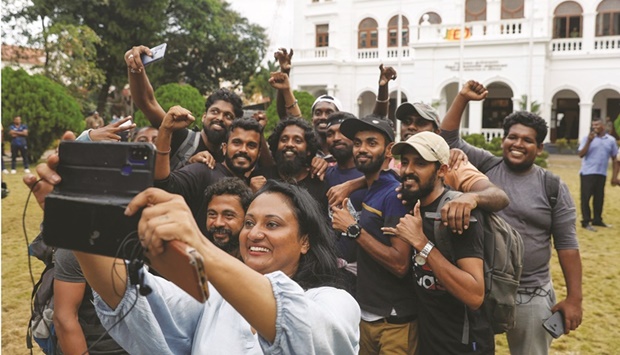Sri Lankan president Gotabaya Rajapaksa submitted a letter of resignation yesterday, a spokesperson for the parliament speaker said, hours after fleeing to Singapore following mass protests over an economic meltdown.
The announcement triggered jubilation in the commercial capital Colombo where protesters massed outside the presidential secretariat, defying a city-wide curfew.
Crowds set off firecrackers, shouted slogans and danced ecstatically at the Gota Go Gama protest site, named mockingly after Rajapaksa’s first name.
“The whole country will celebrate today,” Damitha Abeyrathne, an activist, said. “It’s a big victory.”
“We never thought we would get this country free from them,” she added, referring to the Rajapaksa family who dominated the South Asian country’s politics for two decades.
“This is a monumental victory,” said protester Harinda Fonseka. “But it is only a first step.”
Gotabaya Rajapaksa submitted his resignation by e-mail late yesterday.
His resignation would be examined before a formal announcement – expected today – is made, the speaker’s spokesman Indunil Yapa said.
“The authenticity and the legality of the e-mail will have to be checked out” before being formally accepted, Yapa told AFP.
Rajapaksa would be the first president to resign since Sri Lanka adopted a presidential system of government in 1978.
Rajapaksa fled to the Maldives on Wednesday, then headed on to Singapore yesterday on a Saudi Arabian airline flight, according to a person familiar with the situation.
A passenger on the flight, who declined to be named, told Reuters that Rajapaksa was met by a group of security guards and was seen leaving the airport VIP area in a convoy of black vehicles.
Airline staff on the flight told Reuters the president, dressed in black, flew business class with his wife and two bodyguards, describing him as “quiet” and “friendly”.
The former Maldivian president Mohamed Nasheed is believed to have played a behind-the-scenes role in getting Rajapaksa out of the country, and said Rajapaksa feared he would be killed if he remained.
“I believe the president would not have resigned if he were still in Sri Lanka, and fearful of losing his life,” Nasheed tweeted.
Singapore’s foreign ministry said Rajapaksa had entered the country on a private visit, and had not sought or been granted asylum.
Rajapaksa’s decision on Wednesday to make his ally Prime Minister Ranil Wickremesinghe the acting president triggered more protests, with demonstrators storming parliament and the premier’s office demanding that he quit too.
“We want Ranil to go home,” Malik Perera, a 29-year-old rickshaw driver who took part in the parliament protests, said earlier yesterday. “They have sold the country, we want a good person to take over, until then we won’t stop.”
Protests against the economic crisis have simmered for months and came to a head last weekend when hundreds of thousands of people took over government buildings in Colombo, blaming the Rajapaksa family and allies for runaway inflation, shortages of basic goods, and corruption.
Rajapaksa is accused of mismanaging the island nation’s economy to a point where it has run out of foreign exchange to finance even the most essential imports, leading to severe hardships for its 22mn people, with four out of five Sri Lankans skipping meals.
Sri Lanka defaulted on its $51bn foreign debt in April and is in talks with the International Monetary Fund (IMF) for a possible bailout.
The island has nearly exhausted its already scarce supplies of petrol with the government ordering the closure of non-essential offices and schools to reduce commuting and save fuel.
Inside the president’s residence early yesterday, ordinary Sri Lankans wandered the halls, taking in the building’s extensive art collection, luxury cars and swimming pool.
“The fight is not over,” said Terance Rodrigo, a 26-year-old who said he had been inside the compound since it was taken over by protesters on Saturday. “We have to make society better than this. The government is not solving people’s problems.”
Protest organisers handed back the president and prime minister’s residences to the government in the evening yesterday.
“With the president out of the country ... holding the captured places holds no symbolic value anymore,” Chameera Dedduwage, one of the organisers, told Reuters.
Another organiser, Kalum Amaratunga, said a crackdown could be imminent after Wickremesinghe branded some protesters “fascists” in an address the previous evening.
The government imposed a curfew in Colombo from noon (0630 GMT) yesterday to early morning today in a bid to prevent further unrest.
Local media showed armoured vehicles with soldiers atop patrolling the city’s streets.
The military said troops were empowered to use force to protect people and public property.
Police said one person was killed and 84 injured in clashes between riot police and protesters on Wednesday near the parliament and prime minister’s office, as people demanded the ouster of both Rajapaksa and Wickremesinghe.
The army said two soldiers were seriously injured when they were attacked by protesters near parliament on Wednesday evening and that their weapons and magazines were snatched.
Police said the man who died was a 26-year-old protester who succumbed after he was injured near the premier’s office.
Former prime minister Mahinda Rajapaksa and former finance minister Basil Rajapaksa, both brothers of the president, informed the Supreme Court through their lawyer that they would remain in the country until at least today.
They were responding to a petition filed by anti-corruption body Transparency International seeking action “against persons responsible for the current economic crisis”.
Immigration officials had stopped Basil Rajapaksa from flying out of the country on Tuesday.
Parliament is expected to name a new full-time president on July 20 and a top ruling party source told Reuters that Wickremesinghe was the party’s first choice, although no decision had been taken.
The opposition’s choice is their main leader, Sajith Premadasa, the son of a former president.

Protesters takes a ‘wefie’ before vacating Sri Lanka Prime Minister Ranil Wickremesinghe’s office in Colombo.
